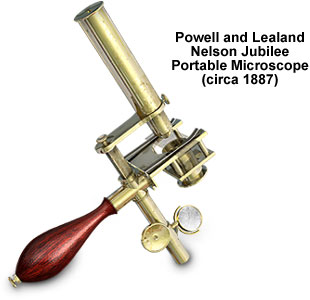Powell and Lealand Nelson Jubilee Portable Microscope
British microscopist Edward Milles Nelson, a developer of the critical illumination technique, designed the Powell and Lealand monocular, compound microscope and exhibited the instrument at the November 9, 1887 meeting of the Royal Microscopical Society in London, England, in the same year as its construction. The model illustrated below was redrawn from photographs of the original microscope, which was described by Gerard Turner in his book The Great Age of the Microscope.

Known as the Powell/Nelson Jubilee Portable Microscope, because 1887 was also the Golden Jubilee year of Queen Victoria, the relatively small brass microscope was considered quite adaptable. Nelson's design was meant to fulfill three separate roles in nineteenth century microscopy, including the need for a small table microscope to complement a larger optical instrument, the demand for a portable microscope useful for showing preparations at meetings, and as a field and classroom demonstration microscope.
The microscope is illustrated with a wooden handle, but alternatively, the brass optical instrument screws into a circular, brass base (not illustrated). A telescoping pillar secures the body tube, which bears an eyepiece inscribed as "12/15m," and one of two objectives. The instrument also features a 1-inch, unsigned objective and another that is signed "Powell & Lealand." The second objective has a focal length of 4/10-inch, and features a correction collar to compensate for the potential variation in cover glass thickness. Coarse focusing is accomplished by rackwork on a triangular bar that fits within the microscope limb.
Unlike most of the fine instruments designed and built by Hugh Powell and his brother-in-law Peter Lealand, including elementary microscopes, the Nelson design lacked a fine focusing mechanism. Vertically-fixed, the stage is outfitted with slide holders, and is capable of rotating 90 degrees for convenient storage in an almost regal, purple velvet-lined mahogany box (not illustrated). The stage supports a substage collar that can hold an achromatic condenser. A gimbal-mounted plane mirror, which is supported by a cranked arm, completes the optical train.
A description of the Powell and Lealand compound microscope was published originally in the Journal of the Royal Microscopy Society in 1887. The stunning example of Victorian ingenuity and fine craftmanship was signed "Powell & Lealand, London. 1887."
BACK TO NINETEENTH CENTURY MICROSCOPES
